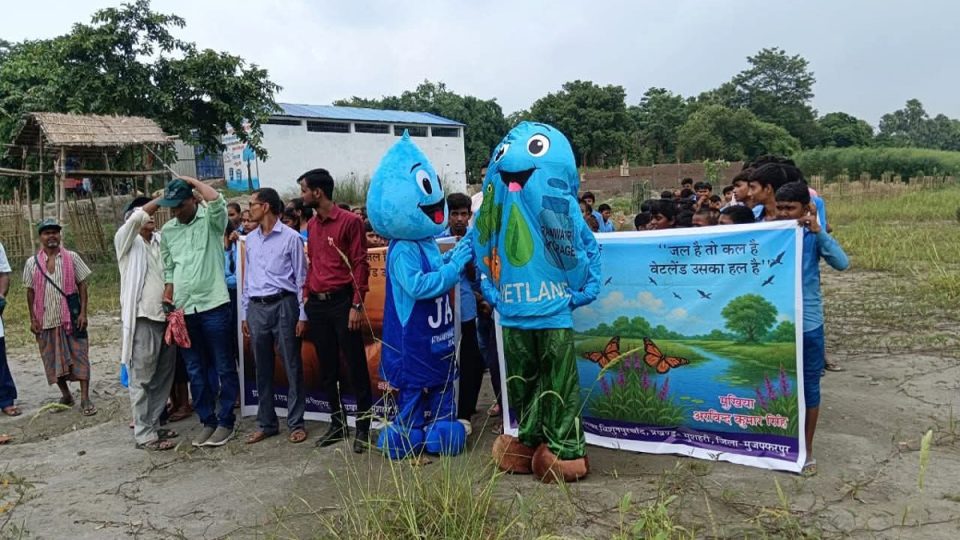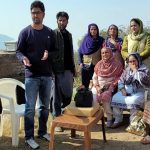Ajay Sahay, Programme Office, District Muzzaffapur / President Safar & our proud Jal Yodha from Bihar
Water scarcity has emerged as one of the most pressing challenges of the 21st century, and the Mushari block of Muzaffarpur, Bihar, has been no exception. Declining groundwater levels, erratic rainfall, and over-dependence on borewells have created serious stress for agriculture, households, and the environment. Recognizing the urgency of the situation, Manika Vishnupur Chand Panchayat has undertaken a comprehensive water conservation and awareness program, integrating both traditional methods and innovative, community-based solutions. This effort stands today as a model for rural India in the march toward Jal Atmanirbhar Bharat 2047.

At the heart of this initiative lies the Manikamaun Wetland, which has been transformed into a dynamic water asset through a massive trenching program. Nearly 30,000 feet of trenches were dug in and around the wetland to ensure that monsoon rainfall is harvested effectively rather than wasted as surface runoff. These trenches act as natural recharge channels, directing water into the soil profile, replenishing groundwater aquifers, and maintaining wetland hydrology. Alongside trenching, 10 new “Khet Pokhari” (farm ponds) were constructed to capture field-level runoff, creating localized water reserves for irrigation and livestock. In addition, five government lands were repurposed for water harvesting, symbolizing the efficient use of public spaces for community benefit.
The ecological dimension of the program was given equal priority. With the understanding that trees are nature’s groundwater banks, the Panchayat undertook a massive plantation drive, planting 20,000 saplings across strategic locations. This “green shield” not only stabilizes soil and reduces erosion but also enhances percolation of rainwater while absorbing significant amounts of carbon dioxide. Further, 50 soakpits were constructed in residential areas to encourage rooftop rainwater harvesting and groundwater recharge, ensuring that every drop of rainfall is stored locally. Together, these measures resulted in the storage of nearly 5 crore litres of rainwater, a remarkable achievement for a single Panchayat.

However, the Panchayat recognized that infrastructure alone cannot solve the water crisis without strong social participation. Hence, awareness campaigns became the soul of the initiative. A series of Pani Panchayat meetings were organized, where villagers were engaged in discussions on water budgeting, the importance of wetlands, and the risks of over-extraction of groundwater. School children were identified as future “Jal Praharis” (Water Guardians), and special Wetland Awareness Programs were conducted for them, combining education with field visits to instill a culture of conservation from a young age.
Innovative tools were deployed to make awareness more engaging. The Panchayat introduced mascots like the Neem Muscat, Wetland Muscat, and Water Muscat, which served as symbolic characters to spread conservation messages during community gatherings, rallies, and school events. To strengthen biodiversity and ecological services, Neem Corridors were developed, highlighting the multiple benefits of Neem trees in providing oxygen, shade, medicinal value, and groundwater recharge. Such creative and culturally resonant approaches ensured that the message of water conservation reached every household in a relatable manner.
This multi-layered program reflects the Panchayat’s vision to go beyond short-term crisis management and build long-term water resilience. By integrating infrastructure development, ecological restoration, social mobilization, and children’s participation, the Panchayat has created a blueprint for rural water security. The collective storage of 5 crore litres of rainwater, coupled with the active role of villagers, has already started yielding visible results—improving groundwater levels, reducing dependence on tankers, enhancing agricultural productivity, and reviving biodiversity around the Manikamaun Wetland.
Most importantly, this initiative aligns perfectly with the national vision of “Jal Atmanirbhar Bharat 2047”. As India prepares for its centenary of independence, villages like Manika Vishnupur Chand demonstrate that sustainable water management is not merely a technical exercise but a people’s movement. When trenches, ponds, plantations, and soakpits are combined with awareness, participation, and ecological thinking, water security becomes achievable even in the most stressed geographies.
In conclusion, the Mushari block’s water conservation journey is not just about numbers—30,000 feet trenches, 20,000 trees, 10 ponds, 50 soakpits, 5 crore litres of storage—but about a transformative shift in mindset. It shows how a Panchayat can empower its citizens to act as custodians of water, wetlands, and forests, ensuring that every drop is valued, every tree nurtured, and every child inspired to become a future water guardian. With such models scaling across India, the dream of a Water-Self-Reliant India by 2047 will not remain a distant vision, but a living reality.








